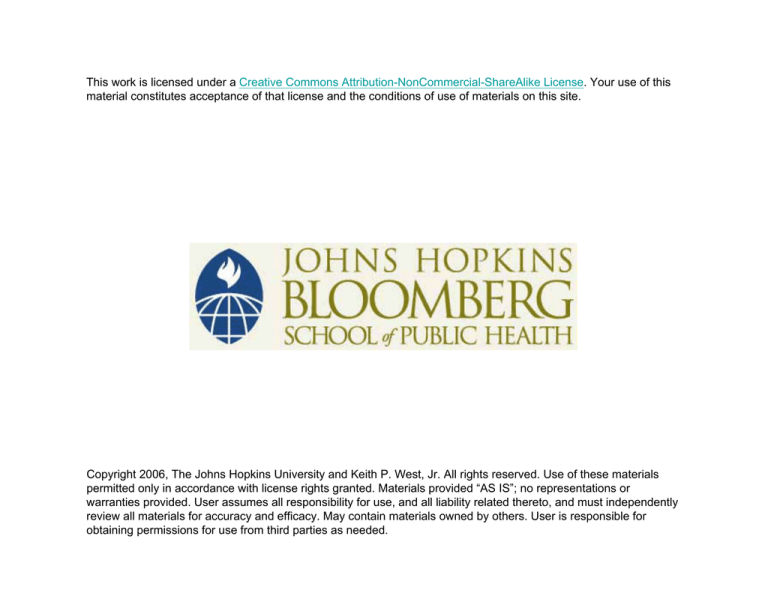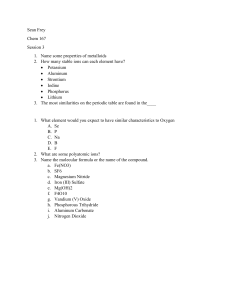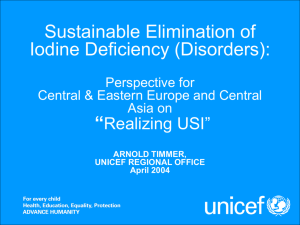
This work is licensed under a Creative Commons Attribution-NonCommercial-ShareAlike License. Your use of this
material constitutes acceptance of that license and the conditions of use of materials on this site.
Copyright 2006, The Johns Hopkins University and Keith P. West, Jr. All rights reserved. Use of these materials
permitted only in accordance with license rights granted. Materials provided “AS IS”; no representations or
warranties provided. User assumes all responsibility for use, and all liability related thereto, and must independently
review all materials for accuracy and efficacy. May contain materials owned by others. User is responsible for
obtaining permissions for use from third parties as needed.
Iodine
Iodine Deficiency
Iodine Deficiency Disorders
(IDD)
Most preventable cause of
mental retardation in the world
Keith P. West, Jr., DrPH
Center for Human Nutrition
Iodine
• Required to produce thyroid hormones
that control cell metabolism,
neuromuscular tissue growth and
development, especially the fetalperinatal brain
• Present in minute amounts (15-20 mg)
in the body
• >90% of iodine stored in the thyroid
Hormones
• Endocrine: produced & circulated
to distant sites of action – vs • Paracrine: act on neighboring
cells
• Autocrine: act on same cells that
produce
Iodine needed for thyroid hormones
- Thyroxine (T4)
- Triiodothyronine (T3)
Iodides attached
to the amino acid
tyrosine
Thyroid hormones regulate numerous
functions: eg
- Biochemical reactions (eg, protein
synthesis, enzyme activities)
- Influence early organ development
(eg, brain through 2-3 yrs of age)
Functions of Thyroid Hormones
• By influencing gene transcription,
thyroid hormones regulate oxygen and
energy utilization, evident through
• Cellular metabolism (oxygen &
energy utilization, ATP production)
• Basal metabolic rate
• Protein synthesis
• Thermogenesis
Used with permission of the ICCIDD.
Thyrotropinreleasing hormone
(TRH) produced by
the hypothalamus
Thyroid-stimulating
Hormone/ Thyrotropin
Negative
feedback
(T3 & T4)
controls TSH
production in the
anterior pituitary
Low T3 & T4 levels
Up-regulate; high
levels down-regulate
the thyroid; increase
in energy need
increases activity
J Dunn, 1991. Used with permission of the ICCIDD.
1
Follicular cells of Thyroid trap iodide ions in blood
2 Follicular cells make & secrete thyroglobulin (TG) with
tyrosine amino acids
3
Iodide anions are oxidized w/ peroxidase to iodine & pass
into colloid
4
Iodine attaches to TG tyrosine AAs. Binding
T1 = monoiodotyrosine
T2 = diiodotyrosine
5
Two T2s couple to make T4 = thyroxine (80% of total); or
one T1 and one T2 couple to make T3= triiodothyronine
(20% of total, but 4x stronger).
6
TG re-enters the follicular cell, merges w/ lysozyme and is
digested. T3 & T4 are cleaved & released.
7
Lipid soluble T3 & T4 diffuse through plasma membrane into
blood
8
T3 & T4 transported by thyroxine-binding globulin (TBG)
Iodine Deficiency Disorders (IDD)
Fetal Iodine Deficiency
Abortion
Stillbirth
Congenital defects
Mental retardation
Paraplegia
Deaf-mutism
Dwarfism
Psychomotor defects
Cretinism
Infant mortality
Neonatal ID
Neonatal goiter
Hypothyroidism
(too little thyroid hormone)
Infant mortality
B Hetzel Lancet 1983;2:1126;
R Semba, 2002
Materno-Fetal Iodine Deficiency:
Neurological Damage
Default
CNS Site *
Intellectual deficit → Cerebral cortex
Deafness
→ Cochlea
Motor rigidity
→ Basal ganglia
* Probable 2nd trimester insult
R. DeLong, 1994
Cretinism
Severe mental retardation
Severe growth deficit
Paraplegia (lower limb
paralysis)
Rigidity
Deaf-mutism
Facial disturbances
The type and severity of
brain, neural and
musculoskeletal defects
arise from timing, severity
and duration of deficiency.
J Dunn, 1991
Photo used with permission of the ICCIDD.
Effects of Iodized Oil in Pregnancy on Infant
Mortality in Papua New Guinea
No.
Births
Deaths
n
%
Cretins
n
%
Untreated
503
97 19.3
26
5.2
Treated
478
66 13.8
7
1.5
RR
0.71
0.29
Pharoah et al, Lancet 1971;1:308
Effects of Infant Iodine Supplementation
on Mortality in Indonesia
• RCT, 617 Indonesian infants,
~6 weeks of age
• 100 mg iodized oil vs placebo
• Motivation: Earlier studies
lowered infant mortality when
pregnant mothers’ iodine status
was corrected
Cobra et al. J Nutr 1997;127:574
Iodine Supplementation Reduced Early
Infant Mortality in Indonesia
Follow-up
RR
(95% CI)
%
Reduction
1 mo
0.20
(0.04-0.91)
80%
2 mo
0.30
(0.10-0.90)
70%
4 mo
0.52
(0.21-1.28)
48%
Cobra et al. J Nutr 1997;127:574
Iodine Deficiency Disorders (IDD)
Child/Adolescent
Goiter
Hypothyroidism
Impaired mental
and physical
development
B Hetzel Lancet 1983;2:1126;
R Semba, 2002
Photo used with permission of the ICCIDD.
Iodine Deficiency Disorders (IDD)
Adult
Goiter
Hypothyroidism
Impaired mental
function
Iodine-induced
hyperthyroidism
(too much thyroid hormone)
B Hetzel Lancet 1983;2:1126
Photo: Keith West
Main Causes of Hypothyroidism
• Iodine deficiency
• Thyroiditis (inflammation) autoimmune (Hashimoto’s Disease)
• Surgical causes
Symptoms of Hypothyroidism
http://www.endocrineweb.com
•
•
•
•
•
•
•
•
•
•
•
•
•
Fatigue ;Weakness
Weight gain or increased difficulty losing weight
Coarse, dry hair
Hair loss
Dry, rough pale skin
Cold intolerance
Muscle cramps/aches
Constipation
Depression
Irritability
Memory loss
Abnormal menstrual cycles
Decreased libido
IDD Globally (WHO, 1994)
At-risk
Total
Millions
% All
Affected
Regions
1,572
29
Goitrous
655
12
Cretinism
11
2
Iodine Deficiency Disorders
Cretinism: 5.7 million
Brain damage: 26 million
Increasing
risk of
mental
impairment
Goiter: 655 million
Population at risk: 1.6 billion
Estimated 1.6 billion people at risk = 30% of the world’s
population. (Mid-1990’s figures.)
Adapted from a British Geological Survey diagram.
Iodine Deficiency: Global & Regional
WHO 2004
UN
Region
Africa
Asia
Europe
LAC
N Am
Oceania
Global
%
Low I
Countries
Intake
(millions)
42
50
53
11
0
75
42
324
1,239
331
47
28
19
1,989
% of
popn
43
36
53
10
10
65
35
Goiter
(millions)
202
505
102
22
4
893
% of
popn
27
15
16
5
13
16
West et al, Intl Pub Hlth Nutr, 2005
Iodine Deficiency Disorders
WHO 2004
54 countries with IDD as public health problem based
on urinary iodine concentration
“Europe is iodine deficient”
Vitti et al., Lancet 2003
Sufficient (UI ≥ 100 µg/L) Deficient (UI < 100 µg/L)
• Austria, Bosnia,
• Belgium, Denmark,
Bulgaria, Croatia,
France, Germany,
Cyprus, Czech Rep.,
Greece, Hungary,
Finland, Macedonia,
Italy, Ireland,
Netherlands, Poland,
Montenegro, Romania,
Portugal, Slovak
Slovenia, Spain,
Rep., Serbia,
Turkey, #Albania
Switzerland, UK,
*Iceland,
*Luxembourg,
*Norway, *Sweden
* Likely sufficient;
# Likely deficient
Iodine Status Assessment
• Goiter classification
• Urinary iodine concentration
• TSH (thyroid stimulating hormone)
concentration
• Other common clinical measures:
• Ultrasonoagraphy of thyroid volume
• Serum concentrations: thyroxine,
TBG, many other analytes
Goiter
This Ecuadorian boy is exhibiting signs of a goiter, an enlargement of the thyroid
gland, due to an iodine deficiency.
Photo courtesy of CDC PHIL:
http://phil.cdc.gov/
Simplified Goiter Classification
Grade
Thyroid Size
0
Not palpable / not visible
1
Palpable in normal position
2
Visible in normal position
Poor response indicator to Universal Iodization of Salt (USI)
WHO, 1994
Epidemiological Criteria for Assessing
Severity of IDD Based on Median
Urinary Iodine Levels (WHO, 1994)
Median Value (µg/l)
Severity of IDD
< 20
Severe IDD
20-49
Moderate IDD
50-99
Mild IDD
≥ 100
No deficiency
Sensitive indicators of iodine intake, not thyroid function
IDD: As a Public Health Problem (WHO, 1994)
Indicator
Goiter grade > 0
Mod/Severe Cut-off
(% of population)
20%
Median urinary iodine
< 50 µg/L
TSH > 5 mU/L blood
20%
(best in newborns)
Thyroid volume
> 97%ile
20%
Best IDD Indicators by Target Group
(WHO, 1994)
Goiter grade >0
School children
Cretinism
Children/adults
Median UI (µg/L)
School children
TSH >5 mU/L blood
Neonates
Thyroid volume >97% ile
School children
Thyroglobulin (DBS)
Children
Iodine Interventions
Universal Iodization of Salt
Iodization of other “Vehicles”
Iodized Oil Supplementation
RDA for Iodine
Infants 0-6 mo:
100 ug
7-12 mo
120 ug
Children 1-8 yr:
90 ug
Adolescents:
120-150 ug
Pregnant/lactating women: 200 ug
Dietary Reference Intakes, Institute of Medicine, National
Research Council, Wash DC, 2001
Iodization of Salt
At a level that assures
150 ug/day is safe for all
populations
WHO, UNICEF, FAO, ICCIDD, IAEA
Photo used with permission of the ICCIDD.
Different levels of sophistication
for producing salt
Photos used with permission of the ICCIDD.
Map used with permission of the ICCIDD.
Prevalence of Goiter Before/After
Salt Iodization Programs
Columbia
Year %
Guatemala
Year %
Before
1945
82
1952
39
After
1952
37
1962
15
1965
3
1965
5
Scrimshaw, 1994
Salt Iodine and Urinary Iodine Concentration
during Pregnancy & Lactation by Month, Nepal
100
Pregnancy
Lactation
Salt
200
90
80
70
60
150
50
40
100
30
% Salt @ 30 PPM
Median Urine Iodine mg/L
250
20
50
10
0
0
J
F
M A
M J
J
Month
A
S
O
N
D
K Schulze et al EJCN 2003
Iodizing Irrigation water in Xinjiang,
China
• Area of severe iodine deficiency
• Potassium iodate added to irrigation
water in 3 villages; control areas
supplied by different irrigation system
• Maternal urinary iodine increased
from <10 to 55 ug/L
• “iodinated water could reduce infant
mortality by approximately half”
DeLong et al, Lancet, 1997; Semba, 2001
Effect of Iodination of Water Supply
in Sarawak, Malaysia
Before
Iodination
61
9 Mo After
Iodination
30
Serum T4 (nmol/L)
80
109
Urinary iodine (g/L)
20
178
Serum TSH (U/L)
12
<4
Goitre (%)
Maberly, et al, 1981
Iodized Oil Supplementation
Target Group: Women during pregnancy
and 1st year post-partum;
Children
When/Where:
• IDD moderate-severe
• Cretinism/neonatal hypothyroidism
• No universal salt iodization for 1-2 yr
Effect of Iodized Oil in Tanzanian
School Children
Before
Urine iodine
(ug/g Cr.)
% children with
TSH >5 mU/L
After 1 Yr
2.6
39.0
61.0
2.0
Source: TFNC, Tanzania
Iodized salt
• Universally and regularly consumed
• Costs ~$0.04/yr/person
• Simple technology
Iodized oil
• Effective in high risk groups
• Administered every 6 to 12 months
Animals will probably
Receive widely (universally)
distributed iodized salt;
but not iodized oil
Goitrogens
eg, Thiocyanate found in cassava
•
•
•
•
Insufficient soaking or cooking
SCN decreases I uptake by thyroid
Suppresses circulating T4
Problem where I intake is marginal
Photo: Keith West
Photo: Keith West
Successful advocacy
• Every year China loses 60-70
million IQ points due to IDD
• Newton's IQ was 190
• China is losing 368,000 Newtons
every year
PRC Ministry of Health Endemic Disease
Control Office, 1997
Virtual Elimination of IDD
1985
ICCIDD founded
1990
World Summit for Children
1991
Conference on Ending
Hidden Hunger (Montreal)
ICN, Rome
1992
1994
UN Committee on Health
Policy Statement on USI
Web resources
• Thyroid Manager
• www.thyroidmanager.org/
• ICCIDD – International Council for the
Control of Iodine Deficiency Disorders
• www.people.virginia.edu/~jtd/iccidd/
• PAMM – Program Against
Micronutrient Malnutrition
• www.sph.emory.edu/PAMM/iodine.htm
Copyright 2005, Keith P. West, Jr. and The Johns Hopkins University. All rights reserved. Use of these materials permitted only
in accordance with license rights granted. Materials provided “AS IS”; no representations or warranties provided. User assumes
all responsibility for use, and all liability related thereto, and must independently review all materials for accuracy and efficacy.
May contain materials owned by others. User is responsible for obtaining permissions for use from third parties as needed.






